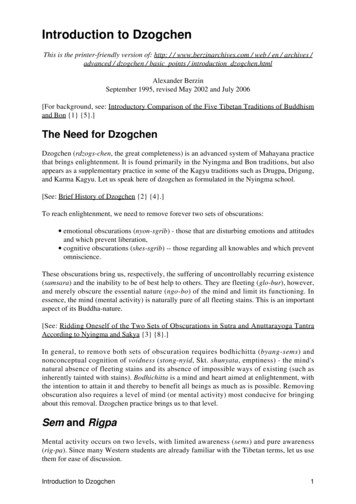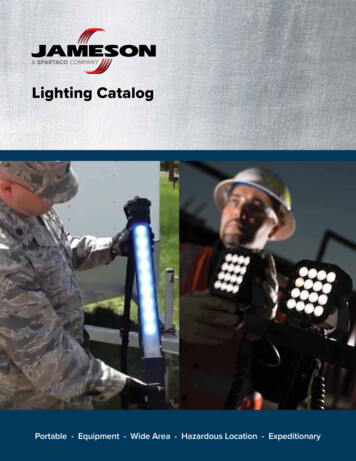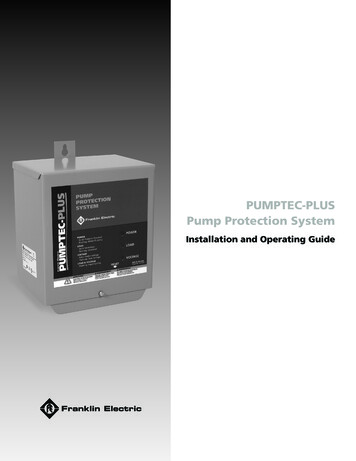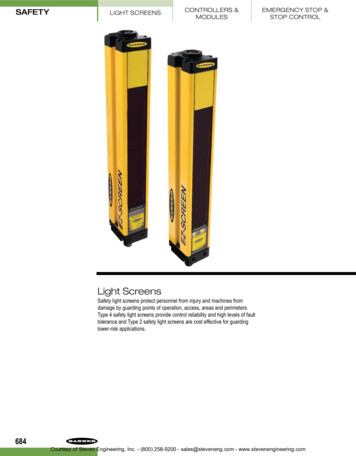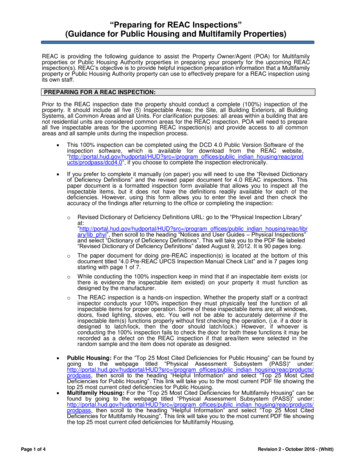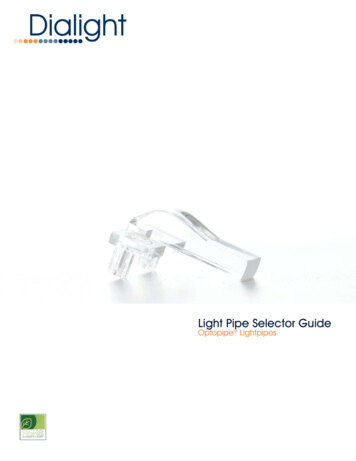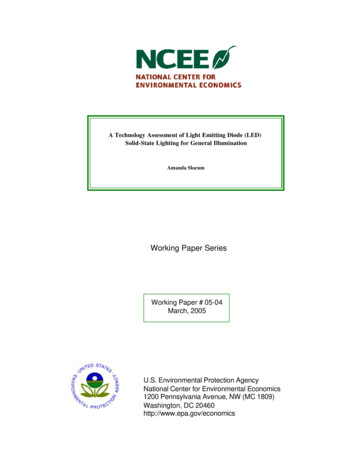
Transcription
A Technology Assessment of Light Emitting Diode (LED)Solid-State Lighting for General IlluminationAmanda SlocumWorking Paper SeriesWorking Paper # 05-04March, 2005U.S. Environmental Protection AgencyNational Center for Environmental Economics1200 Pennsylvania Avenue, NW (MC 1809)Washington, DC 20460http://www.epa.gov/economics
A Technology Assessment of Light Emitting Diode (LED)Solid-State Lighting for General IlluminationAmanda SlocumCorrespondence:Amanda Slocum1741 Lanier Place #44Washington, DC 20009aslocum@nsf.govNCEE Working Paper SeriesWorking Paper # 05-04March, 2005DISCLAIMERThe views expressed in this paper are those of the author(s) and do not necessarily representthose of the U.S. Environmental Protection Agency. In addition, although the research describedin this paper may have been funded entirely or in part by the U.S. Environmental ProtectionAgency, it has not been subjected to the Agency's required peer and policy review. No officialAgency endorsement should be inferred.
A Technology Assessment of Light Emitting Diode (LED)Solid-State Lighting for General IlluminationByAmanda SlocumRochester Institute of TechnologySummer Internship with NCEEAddress for Correspondence:Amanda Slocum1741 Lanier Place #44Washington, D.C. 20009Phone : (703) 292-7853Email : tive technologies can play a major role in curbing emissions of GHG that contribute toglobal climate change. Solid-state lighting (SSL) is one recent example of an innovativetechnology, which has received considerable attention in the last several years. This emerginglighting technology has tremendous potential to become significantly more energy-efficient thanlighting technologies that are currently used, such as incandescent and fluorescent lighting.The purpose of this report is to provide an overview on SSL technology for the U.S.Environmental Protection Agency (EPA) and to serve as a reference for future work in thistechnology area. This report was prepared using the methodological approach of a “technologyassessment”. An overview of SSL is provided, and the drivers and barriers to its use as generalillumination lighting are discussed. The report also highlights both potential environmentalbenefits and negative impacts, which might accompany the development and use of this emergingtechnology.KeywordsSolid-state lighting; LEDs; energy-efficiency; technology assessmentSubject Area ClassificationEnergy (#33); Climate Change (#45)
TABLE OF CONTENTSFIGURES & TABLES .3ACRONYMS & ABBREVIATIONS .4I. INTRODUCTION .5II. LIGHTING TECHNOLOGIES & ENERGY CONSUMPTION .9CONVENTIONAL LIGHTINGTECHNOLOGIES . 10LIGHTING ENERGY CONSUMPTION. 15III. SOLID -STATE LIGHTING.18BASIC LED SCIENCE . 18THE “WHITE” LED . 20MANUFACTURING PROCESS . 23THE INDUSTRY . 25LED APPLICATIONS & ENERGY-EFFICIENCY POTENTIAL. 27IV. DRIVERS .42ENVIRONMENTAL. 43PERFORMANCE & HUMAN INTERACTION. 46SAFETY. 48ECONOMIC. 48ENERGY . 50SPIN-OFFS. 51V. CHALLENGES .51TECHNICAL. 52INFASTRUCTURE. 57MARKET . 59VI. SOLID-STATE LIGHTING: SCOPING LIFE-CYCLE ASSESSMENT .61MATERIALS . 62ENERGY . 71PRELIMINARY CONCLUSIONS . 76VII. PUBLIC POLICY .77BACKGROUND ON U.S. EFFORTS . 77SUMMARY OF FOREIGN EFFORTS. 79VIII. RECOMMENDATIONS & FUTURE RESEARCH .80EPA’S POTENTIAL ROLE IN SOLID-STATE LIGHTING. 80APPENDIX 1. LIGHTING TECHNOLOGY TABLE .82APPENDIX 2. LIGHTING GLOSSARY .83APPENDIX 3. UNITS & CONVERSION FACTORS .84REFERENCES .852
FIGURES & TABLESTABLESTable II-1.Lighting Technology Efficacies16Table II-2.Distribution of Lamps, Lighting Electricity Consumed, and LampOutput -per Sector by Lamp Type17Roadmap Targets for LED-SSL Technology in Comparison to ConventionalLighting Technologies24Table III-2.Applications of High Brightness LEDs in 200229Table IV-1Projections of LED Solid-State Lighting Lamp Costs vs. Conventional LampCosts51Table VI-1Energy Life Cycle Assessment of Two Lamps: Incandescent vs. CFL75Table VI-2Comparison of Energy Consumption of 3 Lamps (Production & Use)78Figure II-1.U.S. Energy Consumption for Lighting in 2001 (Per Sector by Lamp Type)19Figure III-1.Basic Indication LED22Figure III-2.Illumination LED22Figure III-3.U.S. Electricity Saved and Potential Savings of Selected Niche Applications33Figure III-4.U.S. Primary Energy Consumption for Lighting: Three Scenarios38Figure III-5.Electricity Savings from SSL by Sector39Figure VI-1Simplified Flow of a Product’s Life Cycle65Table III-1.FIGURES3
ACRONYMS & EPAGaAsGHGHB dvanced Technology Program (NIST)Color correlated temperatureCompact fluorescent lampCommission Internationale de l'EclairageCarbon dioxideColor rendering indexDefense Advanced Research Projects Agency (DOD)Department of EnergyEnergy Efficiency and Renewable Energy (DOE)Energy Information Administration (DOE)Environmental health and safetyEnvironmental Protection AgencyGallium ArsenicGreenhouse gasesHigh-brightness light emitting diodesHigh-intensity dischargeHigh-pressure sodiumIlluminating Engineering Society of North AmericaIndium ArsenicIndium PhosphideIntegrated Risk Information SystemLife cycle assessmentLight-emitting diodesLight-emitting diode solid-state lightingLighting Research CenterMolecular beam epitaxyMillion metric tons of carbon equivale ntMetal organic chemical vapor depositionMaterials Safety Data SheetsNorth American Industrial Classification SystemNational Energy Modeling SystemNational Institute of Standards and TechnologyOriginal equipment manufactureOptoelectronics Industry Development AssociationOrganic light emitting diodesMercury vaporMetal halideRed-green-blueSolid-state lightingUnited States Geological SurveyYttrium aluminum garnet4
I. INTRODUCTIONGlobal climate change is one of the most serious environmental problems facing thisgeneration. Average global temperatures have risen by approximately 0.6 C (1.1 F) in the lastcentury, and this trend is expected to continue and even accelerate over the 21st century (IPCC,2001). As the warming continues, the effects of climate change are likely to have adverseimpacts on environmental and socio-economic systems throughout the world, although the extentof these impacts is highly sensitive upon the rate and the magnitude of the climate change overthe next century (IPCC, 2001).There is growing consensus in the scientific community that the warming trend is a result ofrising atmospheric concentrations of greenhouse gases (GHGs) (NRC, 2001). These GHG areaccumulating in the atmosphere as a result of human, or anthropogenic, activities such as fossilfuel combustion. Currently in the United States, fossil fuel energy sources (including coal,natural gas, and oil) are used to generate approximately 70% of U.S. electricity (EIA, 2004).When fossil fuels are burned to extract energy, carbon dioxide (CO2 ), one of the primary GHG isreleased into the atmosphere. Atmospheric concentration levels of CO2 have been extracted fromice core samples taken in Antarctica and Greenland. These samples show that CO2 concentrationlevels today are higher than those of pre-industrial times, and have followed an upward trend overthe last 43 years. A 2001 report from the National Academies conclusively attributed the risingconcentration of CO2 to anthropogenic activities (NRC, 2001). Of these anthropogenic activities,fossil fuel burning has been, and is projected to be, the most significant source of CO2 emissions.Innovative technologies can play a major role in curbing emissions of GHG that contributeto global climate change. Solid-state lighting (SSL) is one recent example of an innovativetechnology, which has received considerable attention in the last several years. This emerginglighting technology has tremendous potential to become significantly more energy-efficient thanlighting technologies that are currently used, such as incandescent and fluorescent lighting.5
Currently in the U.S., approximately 22% of the electricity generated is used for lighting.Put into a broader context, the DOE estimates that 8.3% of U.S. primary energy consumptiongoes to lighting (DOE, 2002). Solid-state lighting has the potential to significantly reduce theelectricity needed for lighting. Estimates for lighting energy savings potential have been asoptimistic as a 50% reduction by 2025, which would in turn decrease total electricityconsumption by about 10% (Tsao, 2004). In the U.S., a recent analysis using a SSL marketpenetration model found that by 2025, SSL in general illumination applications could reduce theamount of electricity needed for lighting by 33% (DOE, 2003b).Policies that promote technological innovation are an important strategy for reducing GHGemissions. Well-designed policies to develop and diffuse new environmentally benigntechnologies have the potential to play an important role in reducing the emission of GHG andmitigating the impacts of climate change. These technological advancements can be realized by(1) increasing the efficiency of technologies in order to reduce the energy demanded, (2)substituting old high-carbon energy technologies with low- or zero-carbon technologies, (3)capturing the carbon either before or after it enters the atmosphere, and (4) developing technologywhich reduces the emissions of GHG other than CO2 (Alic, Mowery, & Rubin, 2003).Solid-state lighting is an emerging energy-efficient technology, with high potential to fulfillthe first of these four technology pathways identified above. Research and development isunderway worldwide to develop SSL suitable for general illumination. In the U.S., theDepartment of Energy (DOE) and industry have recognized this opportunity and are pushing for anational initiative to accelerate the development of this promising technology (Haitz, Kish, Tsao,& Nelson, 2000). Solid-state lighting is eventually expected to become approximately twice asefficient as fluorescent lighting, and up to ten times as efficient at incandescent lighting.The purpose of this report is to provide an overview on SSL technology for the U.S.Environmental Protection Agency (EPA) and to serve as a reference for future work in thistechnology area. It should be noted that the term “solid-state lighting” encompasses two distinct,6
yet both promising, technologies: organic light-emitting diodes (OLEDs) and inorganic lightemitting diode (LEDs). It is the latter of these technologies that this report is explicitly focusedon, although both are expected to play important roles in future lighting applications. The scopeof this report is predominantly limited to only LED-SSL technology; although some SSL energyestimates from the DOE that will be discussed have combined the potential of LED and OLEDtechnology.This report was prepared using the methodological approach of a “technology assessment”similar to those that were once performed by the now defunct, U.S. Office of TechnologyAssessment. While all efforts were made to be as comprehensive as possible, completetechnology assessments traverse a wide terrain and only limited time was available to prepare thereport. There is a considerable amount of literature available on LED-SSL, but none directlyfocused on the environmental impacts from a product life cycle perspective. Hence, specialconsideration was given to highlighting both potential environmental benefits and negativeimpacts, which might accompany the development and use of this emerging technology. Thescope of the report is predominately limited to LED-SSL used within the U.S., although SectionIV does describe work being done by a humanitarian organization, Light Up the WorkFoundation, which is bringing LED-SSL technology to developing nations. The remainder of thereport is structured as follows:Section II provides an overview of lighting technologies that are currently used, includingsome basic information on how they work, their applications, and particular characteristics. Themost current data available on the energy consumed by lighting is presented, broken down bylighting technology and market sector (residentia l, commercial, industrial and outdoor stationary).Section III is an overview on LED-SSL technology including the history of the developmentof the underlying technology – lighting-emitting diodes (LEDs), the basic science of LEDs, andthe materials and processes used to manufacture them. The focus will be on the newestgeneration of LEDs, the so-called high-bright LEDs (HB LEDS). These have already begun to7
penetrate and gain significant market share in a number of niche applications, and rapid pacetechnology development indicates that these niche applications will continue to grow. Thissection will provide an introduction to the exciting challenge of developing and deploying whiteLED-SSL in general illumination applications, a challenge dubbed by industry as the “holy grail”.Finally, the energy-savings estimates on the potential of LED-SSL in both niche and generalillumination applications will be reviewed.Section IV describes the major drivers that are propelling forward the development LED SSL technology for general illumination. These drivers are grouped into the following sixcategories: environmental, performance and human interaction, safety, economic, energy, andpotential technology spin-offs.Section V will present an overview of technical, infrastructure-related, and market barrierswhich could hinder the development and adoption of LED-SSL for general illumination.Section VI provides a high-level scoping assessment of potential life cycle impacts from thisnew technology. To date, most work has been concentrated on the environmental benefits to begained from the expected energy-efficiency advantage of solid-state lighting. However, there hasbeen little to no work holistically assessing the environmental issues during entire life cycle –from natural resource extraction through to final disposal.Section VII focuses on the nexus between SSL and public policy. Current U.S. efforts aswell as initiatives in other countries to develop this technology are reviewed. The role of the U.S.EPA in the development and adoption of LED-SSL is discussed in context of (1) the potential ofLED-SSL to potentially provide substantial energy-efficiency savings thereby helping to mitigateglobal climate change and (2) the life-cycle implications of LED-SSL.Section VIII contains concluding remarks and recommendations for future EPA research.8
II. LIGHTING TECHNOLOGIES & ENERGY CONSUMPTIONToday, artificial lighting is an essential service in the modern world, providing the lightpeople require for performing a wide variety of visual tasks. Solid-state lighting (SSL) hastremendous potential to become a revolutionary lighting technology by ushering in an entirelynew lighting paradigm. One major benefit that is propelling this transition forward is the potentialfor significant energy savings from the development and adoption of highly efficient SSL.However, in addition to the energy-efficiency potential of SSL, there are a number of otherattributes of lighting technologies that are important determinants for widespread marketadoption. These include aesthetics (lamp design as well as the color of light emitted), purchasingconvenience and distribution channels, ease of use, safety considerations, disposal requirements,maintenance requirements, and the initial capital cost.In order to assess the energy efficiency potential of SSL, it is important to understand thestructure of the current lighting market and key attributes that drive lighting technologypurchasing decisions. This is by no means a simple task; the lighting market is a complex anddiverse entity (DOE, 2002). 1 Furthermore, the amount of energy consumed by lighting (andhence the potential for greater energy conservation) also depends on a variety of other factorsbesides the technology that is used. For example, the lighting intensity level, the number of hoursthat the equipment is in use in a given time period, and the design of the lighting system are alsoimportant determinants in final lighting energy consumption (Atkinson et al., 1995).The following section will first include a brief overview of the three main categories oflighting technologies that are currently used: incandescent, fluorescent and high-intensitydischarge (HID). Next, the energy consumption of lighting, and its significance as an end-useconsumer of energy in the U.S. will be discussed.1In this report, resource limitations inhibit an exhaustive overview of the lighting market, however theLighting Market Sourcebook (1997) provides a much more in-depth look at lighting technologies, energyconsumption, market structure, distribution channels, and policy issues(Vorsatz et al., 1997).9
CONVENTIONAL LIGHTING TECHNOLOGIESToday, a large and diverse portfolio of technologies is used to provide lighting service.These lighting technologies can be broadly classified into four main groups of light sources:incandescent, fluorescent, high-intensity discharge (HID), and most recently, SSL. Below arebrief overviews of the four groups of lighting technologies.2 Solid-state lighting is discussed inmuch greater detail in Section III of this report. Definitions of lighting terminology usedthroughout this report can be found in Appendix 2.1.IncandescentInvented in the late 1800s by Thomas Edison in America and simultaneously byJoseph Swan in England, today these lamps provide most of the light used by households.They are also widely used throughout commercial buildings (Vorsatz et al., 1997).Incandescent lamps are very inefficient because 90-95% of the emissions are in theinfrared (thermal) rather than the visible range of the electromagnetic spectrum.Incandescent lamps today have efficiencies or “efficacies,” ranging from 13-25 lumensper Watt (lm/W) (DOE, 2003b). 3 These lamps operate by passing electrical currentthrough a metal filament, which heats the filament to the point of incandescence. Today,these metal filaments are most commonly made of tungsten. Recent technologicaladvancements have shown that with further research, a nanotube filament composed ofcarbon nanotubes might one day be used as more energy-efficient filament forincandescent lamps (Wei, Zhu, & Wu, 2004). An author of the study, Bingquiq Wei,cited that more work needs to be done in this area, but thought that such bulbs could beavailable within three to five years.2These four classifications of lighting technologies all include a number of different sub-classifications oflamp types. These sub-classifications are found in Appendix 1.3“Efficacy” is the terminology used for the energy efficiency of lighting, and is calculated by dividing thequantity of light emitted from the lamp (in lumens) by the power input to the lamp (in watts).10
Despite the current inefficiency of incandescent lamps, they provide severalimportant advantages over the other light sources. These advantages include: an excellentcolor rendering index (CRI)4 and warm color, their ability to be easily dimmed,inexpensiveness, small and lightweight, their ability to be used with inexpensive fixtures,and the simplicity of purchasing, installation, maintenance, and disposal (Atkinson et al.,1995). These lamps are the most prevalent in the residential sector, accounting for anestimated 86% of the lamps used by households and consuming 90% of the electricityused for household lighting (DOE, 2002). They are also widely used in the commercialsector, representing approximately 22% of the installed lamps and consuming 32% of theelectricity used for lighting in the commercial sector (DOE, 2002).2. FluorescentFluorescent lamps were first produced in the U.S. in the late 1930s, and came intogeneral use by the 1950s (Atkinson et al., 1995). Fluorescent lamps produce light byapplying a high voltage across two electrodes, initiating an electric arc discharge thationizes the evaporated mercury in the lamp. The ionized mercury emits mostly UVradiation, which strikes and excites the phosphorus coating on the tube causingfluorescence and producing visible light. These lamps must operate in conjunction with aballast. The purpose of the ballast is to limit the incoming current to a certain value, andto provide the needed start-up and operating lamp voltages. The most commonfluorescent lamps are tubular and four-feet in length. The efficacies of fluorescent lamps– including ballast losses – range between 60-90 lm/W (Atkinson et al., 1995). Theefficacies of fluorescent lighting also depend on the type of ballast used: efficiencies arehigher with electronic ballasts than with magnetic ballasts. A significantly smallerversion of the fluorescent lamp – the compact fluorescent lamp (CFL) – was introduced4The color rendering index (CRI) of a lamp is a measure of how surface colors appear when illuminated bythe lamp, compared to the same surface color appears when it is illuminated by a reference light source ofthe same temperature.11
in the early 1980s as a more energy-efficient and longer lasting alternative toincandescent lamps. These CFLs have efficacies of approximately 55 lm/W.Fluorescent lamps are most commonly used in the commercial and industrial sectors.In the commercial sector they account for 77% of the installed lamps and consume 56%of the total electricity for lighting used in the commercial sector. In the industrial sectorthey account for 93% of the installe d lamps and consume 67% of the electricity that goesto lighting (DOE, 2002). On the other hand, in the residential sector the use offluorescent lighting is limited, and when it is used it is generally restricted to kitchens,bathrooms and utility areas (Vorsatz et al., 1997). Compact fluorescent lamps have beenon the market since the 1980s but initially saw very slow adoption rates. In recent yearsCFLs have begun to gain greater market share within market of retail screw-based lamps,with national sales reaching 2.1% of this market by the end of 2001(Calwell, & Zugel,2003).3. High-Intensity DischargeHigh-intensity discharge (HID) lamps operate similarly to fluorescent lamps in thatthey initiate an arc discharge though a mixture of gases, and they require a ballast toregulate their voltage and current. However, HID lamps differ from fluorescent lightsources in that they operate at very high temperatures and pressures. The three primarytypes of HID lamps are mercury vapor (MV), metal halide (MH), and high-pressuresodium (HPS). These lamps are the most effective when used in applications with limitedstart-ups and shut-downs because of the time they require for starting, which can varyfrom 2-15 minutes depending on the lamp type and whether it starting (cold start) orrestriking (hot start). Including ballast losses, the efficacies of these three HIDtechnologies are: mercury vapor lamps (25-50 lm/W), metal halide lamps (46-100 lm/W),and high-pressure sodium (50-124 lm/W) (Atkinson et al., 1995). Generally HID lampsare used where the color of the light is not a high priority.12
HID lamps are most widely used in the outdoor stationary sector, as well as incommercial and industrial sectors.5 In the outdoor stationary sector, they account for75% of lamp installations, and consume 87% of the electricity used for lighting in thissector (DOE, 2002). In the commercial and industrial sectors, HID lamps account for 2%and 5% of lamp installations. They consume 11% and 30%, respectively, of theelectricity used for lighting in the commercial and industrial sectors (DOE, 2002).4.Solid-StateSolid-state lighting is a relatively new and extremely promising emerging lightingtechnology, which uses either light-emitting diodes (LEDs) or organic light emittingdiodes (OLEDs) as a light source. To date, LED technology is further advanced thanOLED technology, and thus is expected to be the first to enter into the market for generalillumination (Tsao, 2004). However both are expected to eventually play a role in thelighting market. The advantages of LED-SSL over more conventional lightingtechnologies include their low energy consumption, longer lifetime, ruggedness anddurability, compactness, safety from a low operating current, fast “on” time, operabilityin low temperature applications, dimmability, easy installation, and directionality.Many of these inherent advantages of LEDs over conventional lighting sources havealready allowed them to penetrate into the market for niche application lighting. Forinstance, LEDs inherently produce monochromatic light and hence are a natural choicefor indication applications such as traffic lights and exit signs, which require coloredlight. In these cases, the need to use an incandescent light coupled with a filter to convertwhite light to colored light (an inefficient process), is eliminated. Niche lightingapplications in which the compactness, ruggedness, and longevity of LEDs provide a5This “stationary outdoor” sector was used in the 2002 U.S. Lighting Market Characterization reportcommissioned by the Department of Energy. This sector includes lighting installations such as streetlighting, airport runway systems, traffic signals and billboard lighting. Outdoor lighting from mobilesources such as automobiles is not included.13
comparative advantage have also been penetrated by LEDs. Creating truly a white LED SSL to be used as general illumination is the greatest challenge of all, but experts areoptimistic that in t
A Technology Assessment of Light Emitting Diode (LED) Solid-State Lighting for General Illumination. Amanda Slocum . Correspondence: Amanda Slocum 1741 Lanier Place #44 Washington, DC 20009. aslocum@nsf.gov. NCEE Working Pap

